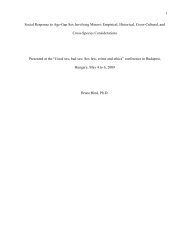Infant and Child Sexuality: A Sociological Perspective - Ipce
Infant and Child Sexuality: A Sociological Perspective - Ipce
Infant and Child Sexuality: A Sociological Perspective - Ipce
You also want an ePaper? Increase the reach of your titles
YUMPU automatically turns print PDFs into web optimized ePapers that Google loves.
fondling between the ages of eleven <strong>and</strong> thirteen).<br />
Masturbation led to orgasm.<br />
In the following case a preadolescent girl attributes part of her<br />
sexual “awakening” to sex dream experience.<br />
Wild <strong>and</strong> confused dreams made me feel funny--<br />
just as if I had to urinate. The dreams included<br />
boys <strong>and</strong> girls kissing, <strong>and</strong> the funny feeling I<br />
got was both distressing <strong>and</strong> exciting. I had no<br />
idea as to what the dreams meant, but I definitely<br />
realized that they pertained to sex.<br />
The incidence of preadolescent sex play at particular ages, that<br />
is, the active incidence, appears to be highest for girls in the<br />
younger years of preadolescence rather than in the older years of preadolescence.<br />
Some eight percent of the females in the Kinsey sample recalled<br />
heterosexual sex play at ages five <strong>and</strong> seven, but fewer recalled<br />
it at later years of preadolescence. Only three percent recalled that<br />
they were having sex play just before pubescence. For most, preadolescent<br />
play had been restricted to a single experience or to a few stray<br />
experiences. Exceedingly few of the girls seemed to have developed any<br />
pattern of frequent or regular sex activity. One girl for every seven<br />
boys was having heterosexual play near the approach of adolescence; the<br />
girls who do accept contacts at that age apparently have more than one<br />
male partner. (Kinsey, 1953, p. 110-111).<br />
At each age, pre-pubertal boys report more sexual activity of every<br />
kind than do girls. (Broderick, April 1966). The marked differences<br />
in incidence for boys <strong>and</strong> girls just prior to puberty may in part<br />
depend on the increased restraints that are placed on girls by their<br />
parents as they approach puberty--restraints which girls often resent<br />
after a carefree childhood. (Martinson, 1966).<br />
The preadolescent boy’s capacity for specific sexual responses develops<br />
rapidly as he nears preadolescence. It is not matched by a similar<br />
capacity in the female. The male subculture also actively advocates<br />
sexual activity for the male. This no doubt affects the incidence of<br />
sexual experiences among preadolescent boys. The importance of biological<br />
over social factors in the incidence differential between preadolescent<br />
boys <strong>and</strong> girls is difficult to measure. Broderick <strong>and</strong> Udry<br />
(1966) among the sociologists of sex emphasize social factors; Kinsey<br />
placed more emphasis on physical capacity.<br />
The Generalized Other <strong>and</strong> Preadolescent Sexual Encounters<br />
The community, peers, parents, the school, the church, <strong>and</strong> others<br />
(referred to as the generalized other) play a larger part in sexual encounters<br />
of preadolescents than they do for infants <strong>and</strong> young children.<br />
One method of controlling the sexual activity of preadolescents is<br />
to separate the sexes <strong>and</strong> keep them under surveillance. Among the<br />
Abipone, for instance, boys <strong>and</strong> girls are strictly segregated at all<br />
times <strong>and</strong> premarital chastity is said to have been universal. A similar<br />
situation exists among the Arapaho, Cheyenne, Papago, <strong>and</strong> Wapisiana,<br />
all of whom keep the sexes strictly apart from childhood. Boys <strong>and</strong><br />
82
















